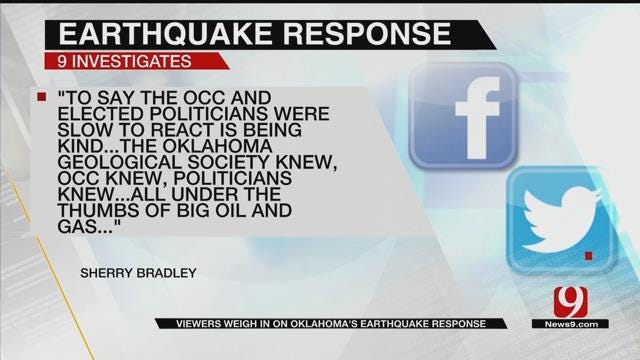9 Investigates: Oklahoma's Response To Earthquakes
<p>Frustrated. That sums up how a lot of Oklahomans feel about the state's response to a dramatic increase in earthquakes over the past eight years. </p>Thursday, August 4th 2016, 10:56 pm
Frustrated. That sums up how a lot of Oklahomans feel about the state's response to a dramatic increase in earthquakes over the past eight years.
Critics of the state's handling of the increased seismicity, which scientists believe has been induced by oil and gas activity, say those who were in a position to do something did too little, too late.
9 Investigates recently sat down with three elected officials who were in such a position, and who defend their actions and say they have done far more than most people are aware.
Bob Anthony, Dana Murphy, and Todd Hiett sit at the helm of the Oklahoma Corporation Commission, the agency that, among other things, has primacy over the state's UIC -- Underground Injection Control -- program. In that role, the commissioners exert regulatory control over the saltwater disposal wells that science has linked to most Oklahoma earthquakes.
In separate interviews (sitting down together, without public notice, would violate the state's Open Meeting Act), each spoke of the complexity of the seismicity issue and the difficulty in deciding what actions to take.
"If there was an earthquake 'off' switch," said Commissioner Dana Murphy, "we would have hit that a long time ago."
"We had a variety of scientific opinions, many not aligned with one another," remarked Todd Hiett, the shortest tenured of the three, "so we didn't have good information as a tool."
"Science isn't that simple," stated Commission Bob Anthony, "there are several causes of earthquakes -- some are man-made and some are not man-made."
Man-made or not man-made, the state, historically, has had relatively few. Prior to 2009, Oklahoma was averaging between one and two 3.0 magnitude or greater earthquakes per year. But in 2009, there were 20 temblors of that strength. The number jumped to 43 in 2010. In 2013, there were 103, 585 in 2014, and 890 last year.
A damaging, 5.6 magnitude earthquake centered near Prague in November, 2011 -- the strongest quake ever recorded in Oklahoma -- was the event that brought the seismicity issue front and center for most Oklahomans. But, as early as spring 2010, a swarm of quakes was already shaking homes in eastern Oklahoma County, and News 9 was asking scientists at the Oklahoma Geological Survey if disposal wells might be to blame.
"I just can't make the connection, there just doesn't seem to be a link," said OGS research seismologist Austin Holland, in a 2010 interview.
But by 2012, the U.S. Geological Survey was saying the quakes "almost certainly" were man-made, likely triggered by oil and gas activity. Still, the Oklahoma Geological Survey would not go that far.
"It left us without any conclusive evidence," said Commissioner Hiett, "and of course we have to have conclusive evidence."
While Oklahoma leadership waited for more conclusive evidence, regulators in other states -- Arkansas and Ohio, for example -- were aggressively responding to earthquakes in their states, shutting down production and disposal wells, and even putting moratoria in place. Such actions did not go unnoticed in Oklahoma, and the Commission faced criticism for not acting quickly enough.
"I can understand why people would say that," Commissioner Murphy explained, "but the reality is, the very first public meeting that we had following the Prague earthquake was in 2011,"
And more actions followed. In 2013, the Commission implemented what has been termed a "traffic light" system, where applications for new disposal well permits would be approved, modified, or disapproved based on a review of the well's proximity to faults and prior earthquakes. This system continued to evolve and became stricter, as the number and strength of earthquakes continued to increase.
In 2014, the Commission began requiring that operators of all wells injecting into the Arbuckle formation provide pressure and volume data daily, as opposed to monthly. Commissioners also approved the creation of "Areas of Interest" around the epicenters of all magnitude 4.0 or greater earthquakes, helping them to focus regulatory actions in the areas most at risk for earthquakes.
But it wasn't until 2015, when the evidence did become conclusive and state leaders did acknowledge a connection between wastewater injection and earthquakes that the Commission began to address the issue on a larger, regional scale.
Beginning in early 2015, oil and gas companies were forced to plug back any disposal wells that were injecting into the crystalline basement of the Arbuckle, a circumstance that was determined to be a significant risk factor in the occurrence of earthquakes. Further, OCC enlarged the Areas of Interest and required disposal wells within the AOIs to either reduce volume or shut in completely.
"From my own personal standpoint," admitted Commissioner Murphy, "I would have liked to see us move more quickly toward a regional aspect, but I'm one commissioner."
Murphy is not openly critical of her two fellow commissioners -- she says she respects their positions.
Commissioner Hiett only joined the board in January 2015, replacing Patrice Douglas, who stepped aside in order to run for Congress. Hiett feels they've done a good job balancing competing interests, and rejects the notion they've been slow to act.
"There was action, it was action that you couldn't see," stated Hiett. "I mean; the general public could not see that we were out here plugging wells up out of the basement."
Commissioner Anthony, now serving his fifth consecutive six-year term in office, says the Commission has acted as quickly as the science would allow, and he believes it's worked.
"Overwhelmingly, we have avoided the worst-case scenario," Anthony noted.
Anthony says criticism that the Corporation Commission has acted in the interests the oil and gas industry, and not in the best interest of public safety, is simply wrong. He says many of their actions have been punitive to energy companies -- "This is not an easy time for them, but we have made cutbacks that meant they had to curtail their revenue flows and it's been devastating to them," he said.
Certainly, many oil and gas companies have cut back significantly on production, although industry experts agree depressed commodity prices have probably been more responsible for that than have OCC's seismicity directives.
Still, Anthony contends it was important for the Commission to consider the impact of regulation on all stakeholders and to not overreact.
"I think that we don't need to use a sledgehammer to hit a fly," Anthony commented.
More Like This
August 4th, 2016
April 15th, 2024
April 12th, 2024
March 14th, 2024
Top Headlines
April 17th, 2024
April 17th, 2024












